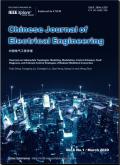Reduced Model of Droop-controlled Converters for Transient Simulation Analysis
Q1 Engineering
引用次数: 0
Abstract
In recent years, the transient stability problems encountered by power grids have increasingly attracted interest due to the connection of renewable energy resources. One of the effective methods for studying the transient characteristics of a system is transient simulation analysis. To reduce the simulation time, especially in a system with numerous renewable energy resources, model reduction has been widely employed. However, when a general reduced model is adopted to analyze different transient characteristics, a tradeoff between accuracy and simulation speed emerges. In this study, reduced model selection is implemented to resolve this problem. Considering the droop-controlled converter as an example, this approach allows the transient simulation analysis of voltage, frequency, and power angle characteristics. First, a full-order model of the droop-controlled inverter is formulated. Thereafter, the singular perturbation method is applied to derive different reduced-order models. Then, considering accuracy and simulation speed simultaneously, the most suitable reduced models for transient angle, voltage, and frequency simulation analyses are determined through time-domain simulation comparison. Finally, the simulation results based on Matlab/Simulink are used to verify the correctness of the reduced model selection.用于瞬态仿真分析的降频控制变换器简化模型
近年来,由于可再生能源的接入,电网遇到的暂态稳定问题日益引起人们的关注。暂态仿真分析是研究系统暂态特性的有效方法之一。为了缩短仿真时间,特别是在具有大量可再生能源的系统中,模型约简被广泛采用。然而,当采用一般的简化模型来分析不同的暂态特性时,就需要在精度和仿真速度之间进行权衡。本研究采用简化模型选择的方法来解决这一问题。以垂控变换器为例,该方法允许对电压、频率和功率角特性进行暂态仿真分析。首先,建立了下垂控制逆变器的全阶模型。然后,应用奇异摄动法推导了不同的降阶模型。然后,同时考虑精度和仿真速度,通过时域仿真比较,确定了最适合暂态角、电压和频率仿真分析的简化模型。最后,利用Matlab/Simulink仿真结果验证了简化模型选择的正确性。
本文章由计算机程序翻译,如有差异,请以英文原文为准。
求助全文
约1分钟内获得全文
求助全文
来源期刊

Chinese Journal of Electrical Engineering
Energy-Energy Engineering and Power Technology
CiteScore
7.80
自引率
0.00%
发文量
621
审稿时长
12 weeks
 求助内容:
求助内容: 应助结果提醒方式:
应助结果提醒方式:


